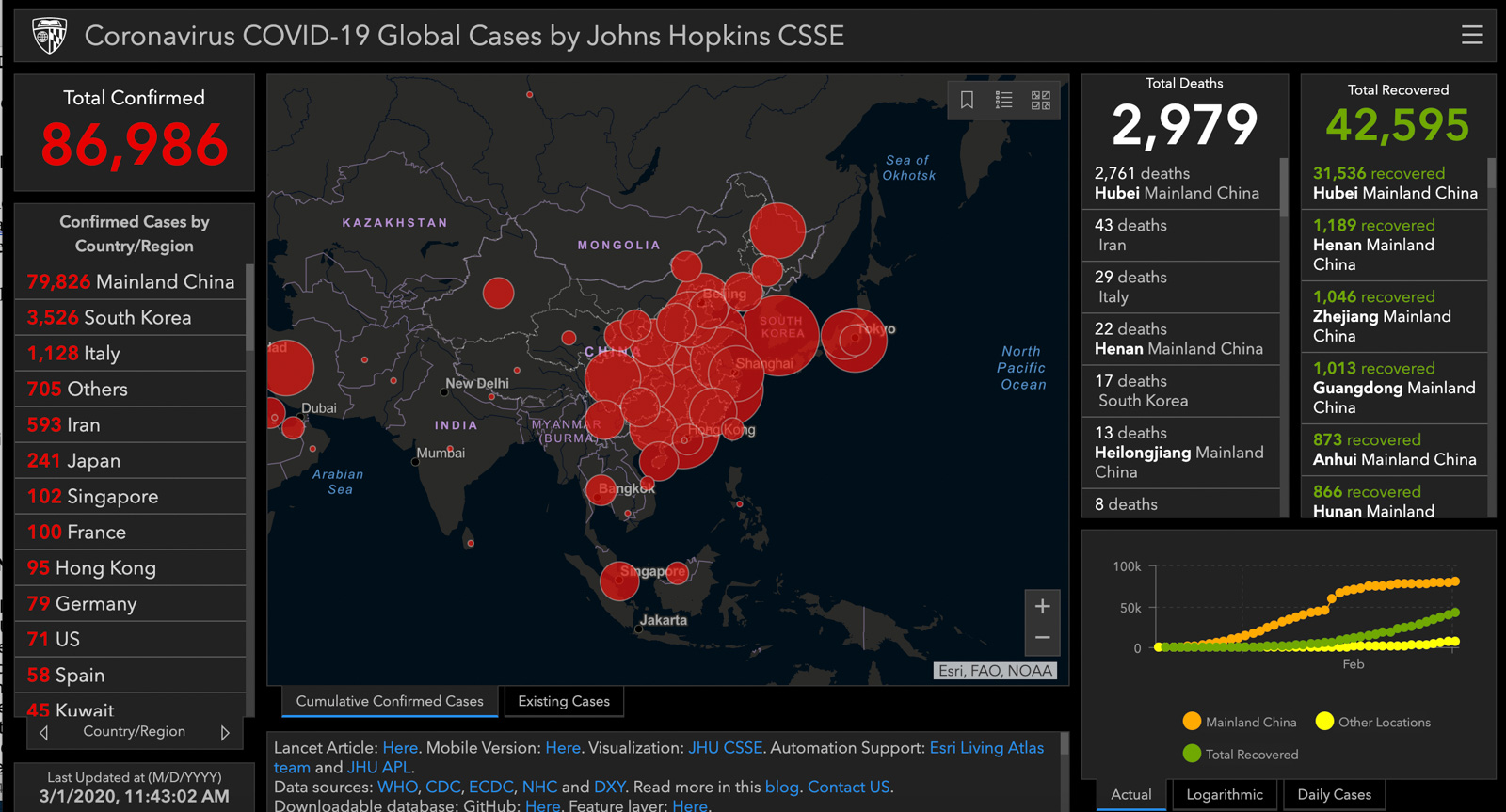This layman’s impression of COVID-19: From information I’ve gathered on the web and what I have heard and seen through the press, TV and radio channels. Post compiled during the weekend of 29th Feb / 1st Mar 2020 (sources included at the bottom of this post): COVID-19 stands for COronaVIrus Disease 2019. It is an illness caused by an infection of our respiratory systems, the infection is created by a virus. Viruses are highly efficient parasites. When viruses find a cell they attack it by latching onto the wall of the cell, almost becoming part of it. Some viruses will manage to get through the wall and into the main body of the cell. When viruses have invaded a cell they take-over the cellular process, they produce a virally encoded protein that replicates the virus’s genetic material and in this way infect the cells they are inhabiting. COVID-19 targets and infects cells that combine to form our lungs.
COVID-19 is frequently compared to the Flu because both illnesses are caused by viruses that attack the cell structure of our vital organs and they both have similar physical effects. The Flu virus is a potentially lethal public health risk and there are various strains of the Flu virus. The deadliest strain in history was the Spanish Flu pandemic of 1918, is estimated to have killed between 20 million and 50 million people world-wide. To put this into perspective, there were 40million people were killed in the 1st World War.
We have figured out how to create vaccines that prevent the Flu virus from gaining access through the wall of the cell so that it can’t infect the cell. Each year we create new Flu vaccine to protect against the latest strain of Flu. We need to do the same for COVID-19, but this could take a year to develop and test, so it will not be in place to deal with the current outbreak..
While the symptoms of COVID-19 and the Flu are similar, they actually come from different families. Influenza viruses are part of the Orthomyxovirus family which are transmitted human to human. COVID-19 comes from the Severe Acute Respiratory Syndrome Coronavirus family (SARS-CoV) and the latest outbreak is reported to have originated from bats.
Other key differences between the two virus types are:
- Level of contagiousness: This is measured by a ‘basic reproduction ratio’ or Rο (R nought); this is the ratio by which the disease spreads from a single human to others Flu has an Ro of 1.3. COVID-19 has an Ro of 2.2.
- Incubation period; For Flu is between 1 and 4 days. COVID-19 has an incubation period of up to 2 weeks
- Mortality Rate: Since the Spanish Flu of 1918, the average mortality rate of patients infected with Flu has settled at less than 1%. Early estimates of COVID-19 from China suggest a mortality rate of greater than 2%, similar to that of the Spanish Flu pandemic.
Based on the above figures, I don’t believe we have sufficient capacity in the UK to effectively treat COVID-19 patients if it becomes a pandemic. We don’t have enough people, infrastructure or equipment in the UK. If (1) and (2) are correct then it feels like the UK is currently walking blindly into the real exposure, as somewhere between 12% and 15% of COVID-19 cases will require hospital treatment and it’s been reported that 5% require intensive care.
I started compiling this post at about 9am, Saturday 29/02/2020: The UK government website was at that time reporting that a total of 8,986 people had been tested in the UK, of which 8,966 were confirmed negative and 20 only positive (data captured on 28th Feb). So far there have been no fatalities in the UK. The latest case in the UK is a guy close to home, in Haslemere, Surrey. Concerns have been flagged on this case because he has not been abroad and is not aware of being in close proximity to anyone who has travelled (or known to be carrying the virus). In some other countries however, things are looking a little more serious. According to the Guardian (posted at 02:22 GMT today) Italy has reported 820 cases detected resulting 21 deaths.
The global picture by 9:23am (reported by the FT ) was 85,406 confirmed cases around the world and 2,924 deaths attributed to the virus. China, where the outbreak started is reporting 79,251 cases. The more I think about this and look into it the more alarming it seems. It feels like it’s just a matter of time before it all starts to happen in the UK.
I went back to the FT source at about 1pm and the global picture had crept up to 2,933 deaths, an increase of 9 deaths recorded in about 5 hours.
The FT sourced the data from the dashboard below which was built and maintained by John Hopkins University Centre for Science and Engineering. This screen shot was taken on Sunday morning and we can see there has been another significant jump.

Click on image to LINK to the latest version of this dashboard. Created and maintained by John Hopkins University Centre for Science and Engineering.
This dashboard combines data reported into the World Health Organisation and official health commissions, institutions in China, US and Europe. I expect to be referring to this dashboard again in future posts to plot how the authorities
As far as I can tell, we are actively take steps to mitigate the risk in the UK. I am hoping that in parallel we will also be actively take steps to reduce the impact on the basis that our mitigation steps will not be effective.
- From media reports it seems that there is already a coordinated effort around the world to improve estimates on likelihood and impact for each country and region. There is currently a lot of planning for a widespread epidemic or a pandemic.
- In the UK plans are being explored to engage the red-cross and bring retired medical staff back into work. These plans include putting controls in place to limit or ban public indoor events, encourage work from home, etc.
- Mitigation planning seems to be focused on ‘containment’ which means that infected people go into isolation. People who may have come into contact with the disease also go into self-imposed isolation. The public is being given advice and information about the disease and how best to reduce the risk of picking it up, for example by washing hands properly, shielding/covering sneezes and coughs, etc.
 According to the Economist and it’s sources, when the virus arrives in a country we should plan for a variance of 25-70% of the population to catch the disease (does this stack up against the Rο of 2.2?). Current trend is for between 12% and 15% of those infected to need hospital treatment and 5% will need intensive care.
According to the Economist and it’s sources, when the virus arrives in a country we should plan for a variance of 25-70% of the population to catch the disease (does this stack up against the Rο of 2.2?). Current trend is for between 12% and 15% of those infected to need hospital treatment and 5% will need intensive care.
The population of the UK is 66.44million. Based on the above statistics for patients requiring hospital treatment and intensive care, I calculate the the NHS needs to prepare for an influx of anything between 2.4 million and 7 million patients if we have a serious un-contained break-out in the UK (calculations to be included below). Am I missing something here ?
This table provides recents stats on current bed availabilities in the NHS. To make matters worse, NHS currently has 44,000 vacancies for registered nurses. This resourcing crisis is due to years of underfunding and compounded by BREXIT. Similar staff shortages are reflected across across all aspects of medical care and social services.
The chart below makes for interesting reading, it compares Critical-Care Bed availability across nation states of Europe.
(needs some further analysis)
In summary, it seems to me that COVID-19 poses a major threat. There is an increased likelihood that the COVID-19 will become a pandemic. If and when this happens (I hope it’s not the case) then we will probably lose friends and/or loved ones to this nasty disease.
I wish that the NHS had not been so starved of funding and resources over the years, this will come back to haunt us in the UK.
References (more to be credited):
Link to the John Hopkins CSS dashboard.
Severe Acute Respiratory Syndrome Coronavirus (SARS-CoV): NCBI Medical Microbiology 4th Edition
Orthomyxovirus: NCBI Medical Microbiology, 4th Eddition
xxx: https://www.livescience.com/coronavirus-myths.html
xxx: https://www.nytimes.com/2020/02/29/health/coronavirus-flu.html Mortality rate
Level of contagiousness: https://www.nejm.org/doi/full/10.1056/NEJMe2002387 Level of contagiousness







